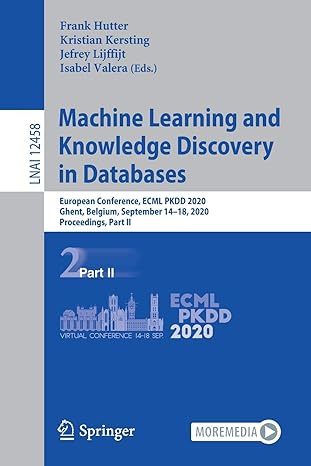Question
An abstract data type is a set of objects and a set of operations on those values. True False Flag this Question Question 210 pts
An abstract data type is a set of objects and a set of operations on those values.
| True |
| False |
Flag this Question
Question 210 pts
The link list consists of a series of nodes, which are necessarily adjacent in memory.
| True |
| False |
Flag this Question
Question 310 pts
The main difference between array and vector type in C++ ...........
| while array elements can be accessed with an index, the vector elements cannot. |
| while array has fixed capacity, the vector size can be changed in runtime. |
| while array elements can be changed in runtime, the vector elements cannot. |
| None of the above |
Flag this Question
Question 410 pts
What is the average running time of searching an element in a linked list?
| O(logn) |
| O(n) |
| O(n2) |
| O(n3) |
Flag this Question
Question 510 pts
In C++, the name of the library for implementation of common data structures is called.....
| Standard Data Library |
| Standard ADT Library |
| Standard Template Library |
| None of the above |
Flag this Question
Question 610 pts
Which of the following is not a major applications of stacks in programming?
| Syntax check for compilers |
| Computation of postfix expressions |
| Conversion from Infix to Postfix notation |
| Sorting objects |
Flag this Question
Question 710 pts
For infix to post-fix conversion procedure described in your textbook, what are the content of the stack and output for the following infix notation:
(x-y)*z
Look at the figures given below starting from left to right and top to bottom.
(Hint: please see the exercise in page 109-110 from your textbook)
|
|
|
|
| None of the above |
Flag this Question
Question 810 pts
When an element is pushed to a stack, the element is inserted to .........
| bottom of the stack |
| center of the stack |
| top of the stack |
| None of the above |
Flag this Question
Question 910 pts
Which of the following is not a procedure for standard stacks?
| pop from stack |
| push to stack |
| enqueue |
| peek top of element |
Flag this Question
Question 1010 pts
What is the average running time of infix to post-fix conversion using stack?
| O(n) |
| O(logn) |
| O(n2) |
| None of the above |
Flag this Question
Question 1110 pts
For the following postfix expression computation as described in your textbook: what should be the content of the stack once the first / operator is scanned:
4 2 - 6 2 / + 1 2 * +
Look at the figures given below starting from left to right.
(Hint: please see the exercise in page 106-107 from your textbook)
|
|
|
| None of the above |
Step by Step Solution
There are 3 Steps involved in it
Step: 1

Get Instant Access to Expert-Tailored Solutions
See step-by-step solutions with expert insights and AI powered tools for academic success
Step: 2

Step: 3

Ace Your Homework with AI
Get the answers you need in no time with our AI-driven, step-by-step assistance
Get Started


